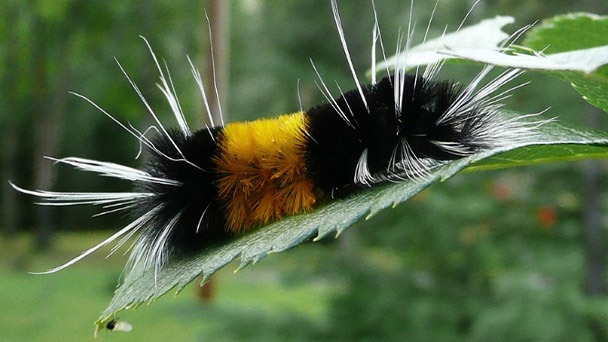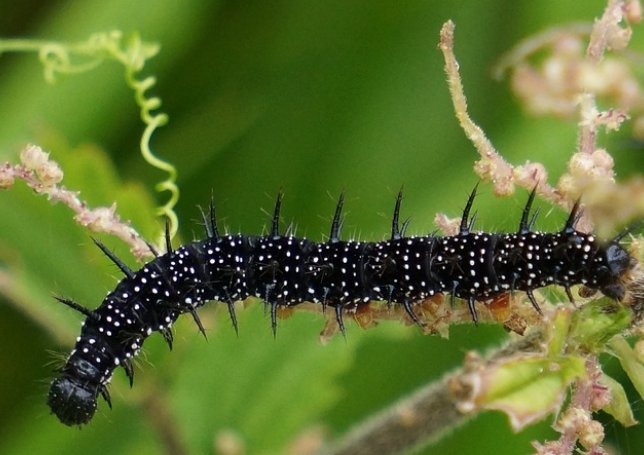Are Black Caterpillars Poisonous - How to Get Rid of Them
Written by Ivy
Jan 06 2023

Most black caterpillars are not poisonous to humans and do not have any poisonous properties. Some varieties of furry, black caterpillars may have spines or barbs that sting and irritate the skin. Butterfly caterpillars do not sting; only furry moth caterpillars can.
What is the Black Spiky Caterpillar?
The caterpillars of the eyed tiger moth are known as black spiky caterpillars. They initially have a fuzzy appearance because of the numerous black spikes that cover their entire body. The black spiky caterpillar will automatically roll into a ball when scared to highlight the red bands, which are scattered throughout the fuzz. That doesn't mean it's dangerous in any way; it's just an attempt to make the enemy feel threatened so they will leave it alone.
Occasionally, if you try to pick it up, they might even leave some yellow liquid on your hand. This is actually a form of defense. Although it is not harmful to your hands, you shouldn't consume it either. Of course, you should always wash your hands after coming in contact with a creature of this nature for your own safety. It should be noted that not all Black Spiky Caterpillars are large, fuzzy creatures. Prior to reaching this level, they must actually pass through several molting stages. Some of the younger Black Spiky Caterpillars actually have very few bands and are black or brown in color.
That's how impressively beautiful these really are, and you should definitely keep those in mind if you can. The majority of them will turn into moths, with the giant leopard moth standing out because its wings almost appear to be made of porcelain.
Where Can You Find Black Fuzzy Caterpillars?
A fuzzy black caterpillar is simple to locate in your garden. Despite their peculiar appearance, they are quite typical, particularly in the summer. On any food plant, such as cabbage or citrus trees, as well as on sunflowers, willows, and magnolias, black fuzzy caterpillars can be found.
Due to their stiff black spikes, which give them a furry appearance, they are very simple to recognize. Woolly bears can occasionally have reddish or brownish patches between their completely black coats, and giant leopard moth caterpillars have thin reddish lines.
Do Black Fuzzy Caterpillars Bite?
Black fuzzy caterpillars do not sting or bite, despite how intimidating they may appear to you given their vivid colors and spiky exterior.
The caterpillar won't sting or bite you, but even though you can hold them, the spines may irritate your skin because they break off into your skin after you touch them. Furthermore, the use of their spines serves to prevent any nearby predators, such as birds, from attempting to pick them up.
Should You Be Worried About Any Poison?
We discovered that, at least in some cases, the black spicy caterpillars are not poisonous. It's important to always keep in mind that neither the tomato hornworm nor the hickory horned devil are poisonous. Having said that, the saddleback caterpillar is experiencing burning from the bristles. You must constantly consider this one because of its vivid green color and plush brown fur. Typically, the bristles will cause a burning sensation and significant swelling. Despite the fact that it is not fatal, dealing with this will undoubtedly hurt a lot, so you must always bear that in mind.
The monarch, stinging rose, cinnabar moth, and bag caterpillars are some other poisonous caterpillars. Keep in mind that each of these should be avoided, and you should be aware of how they appear. Avoiding caterpillars is generally a good idea. You can't always tell which caterpillars are harmless and which ones are harmful because this is not an exhaustive list. The best general rule is to avoid unfamiliar creatures like these whenever possible. You must avoid all of that if you don't want problems.
Can Black Fuzzy Caterpillars Kill You?
They won't sting or bite you, and if you pick them up, woolly bears and enormous leopard moth caterpillars will simply roll up into a ball and act dead.
It may be uncomfortable to touch them due to their prickly skin, but that is the best they can manage. You cannot be killed by a black fuzzy caterpillar. The caterpillars that can kill you, however, are typically unsightly and have vivid colors that make it seem obvious that they want you to stay away from them.
Caterpillars can be very dangerous, such as buck moth caterpillars (as seen below) or hagi moth caterpillars. However, these unusual spikes are more clearly defined and the caterpillars do not have the same fuzzy appearance as those, which are also blackish in color.
One thing that might worry you is that you might have some yellow liquid on your hand after picking up a black fuzzy caterpillar. You don't need to be grossed out or concerned because this yellow liquid is a defense mechanism used by the caterpillar, not pee.
This liquid is safe and won't irritate your skin either. However, you should thoroughly wash your hands after handling these caterpillars because the liquid could be harmful if ingested.

Is It Ok to Bring Black Spiky Caterpillars to Your Yard?
They alter the ecosystem, pollinate flowers, and encourage the production of seeds. Caterpillars are a vital component of the ecosystem, despite the fact that they occasionally carry poison, so you should try to protect them. That doesn't necessarily mean that dealing with them all will be dangerous, but if you approach them correctly and in the right way, you can get some really good outcomes. Just be careful not to rush this process and concentrate on luring caterpillars slowly into the yard.
Willows, sunflowers, mulberries, lilacs, magnolias, citrus, cabbage, basil, angel trumpet, and many other plants are good to have in your yard if you want to attract Black Spiky Caterpillars. If at all possible, include these plants in your garden as they are known to attract Black Spiky Caterpillars in large numbers.
It's safe to come across Black Spiky Caterpillars in the wild and it's acceptable to have them in your garden. But you shouldn't even attempt to touch them. You don't really know if the caterpillar you are currently handling is poisonous or not because each of these insects has its own defense mechanism. The best course of action is to avoid issues and simply gaze admiringly at the caterpillar, as this is what you should do. Maintaining their safety is a great idea because they are crucial to the ecosystem.
How to Get Rid of Caterpillars in the Garden
There are Four Simple Solutions you can use to prevent damage to your trees:
- Contact Insecticide – Spray a permethrin or pyrethroid with PBO during the day. Utilizing an environmentally friendly method and direct larval eradication. It works well to use Dr. Doom, Bio-mist, or Bug-X products.
- Malathion – Use along with any other contact orangophosphate or insecticide.
- Microbial Insecticide – like BTK, but keep in mind that as the larvae grow older, they must ingest the bacteria; therefore, the degree of control might not be very strong. They are properly controlled if they were sprayed earlier in May.
- Broom, Stick, or Scraper – The good old-fashioned method of removing the larval clumps during the daytime using a broom, a stick, or a scraper. Put the caterpillars in a trash bag and dispose of them.
What Do Fuzzy Black Caterpillars Turn Into?
Depending on the kind of fuzzy caterpillar, two different moths emerge from black caterpillars.
Unsurprisingly, it will develop into a giant leopard moth if it is a giant leopard moth caterpillar. These moths have three-inch wingspan and black circles on their white wings. It has some orange parts and some areas with a bluish-black tone.
The Isabella tiger moth, a rare moth, will emerge if the caterpillar is a woolly bear. It has a color similar to caramel or rust, and occasionally it has a cream or yellow appearance.
What Other Caterpillars Are Fuzzy in Appearance?
There are many caterpillars that have a fuzzy appearance.
- The garden tiger caterpillar, which resembles a woolly bear, is brownish and black in color. These don't sting or bite, just like their black and reddish counterparts.
- The rare dagger caterpillar is entirely black with orange spines on the head, tail, and middle. Its appearance makes it appear to predators like a wasp.
- Another fuzzy caterpillar with white spines is the walnut caterpillar. Although the caterpillar's hairs are not poisonous like those on these other species, they are very itchy when they touch the skin.
FAQs
Are there any other questions you have about black and fuzzy caterpillars now that you are aware that they are generally not poisonous? Then check these out:
Are Black Caterpillars Poisonous?
The majority of black caterpillars are not poisonous. They might irritate the skin if they have long hairs or barbs, but it's extremely unlikely that they are poisonous or can harm you permanently.Are Fuzzy Caterpillars Poisonous?
There is a huge variety of fuzzy caterpillars; the majority are unlikely to be poisonous, but this is not the case for all caterpillars. Avoid touching anything if you don't know what you're handling.Are Black and Orange Caterpillars Poisonous?
Though it's all in how they look, most black and orange things appear menacing. They are not poisonous and cannot harm you.How Big Can Fuzzy Black Caterpillars Get?
Caterpillars that are fuzzy and black are typically larger than the average caterpillar. They appear even bigger due to their thin, black spines. These fuzzy caterpillars can only reach a maximum length of three inches.Also Read How to Get Rid of the Following Species:
Animals:
- Ant
- Brown Recluse Spiders
- Hornets
- Palmetto Bugs
- Spider Mites
- Water Bugs
- Grass Flies
- Carpenter Bees
- Beetles
- Scorpions
Summary
Despite having a similar appearance to many dangerous or poisonous insects, black fuzzy caterpillars are neither poisonous nor dangerous. To pupate into a huge leopard moth or an Isabella Tiger moth, depending on the type of caterpillar, you can find them scurrying around your yard eating various plants.
Latest Updated
- Benefits of Bugleweed - 7 Science-backed Health Benefits
- Bugleweed Dangers & Side Effects - Is It Poisonous?
- How to Plant Evergreen Trees - What You Should Know
- When to Plant Evergreens - Grow Guide for Evergreen Trees
- 12 Wonderful Evergreen Shrubs for Your Garden
- 12 Popular Evergreen Plants with Pictures for Beginners
- When And How To Prune A Lilac Bush Like a Pro
- How to Grow & Care for Lilac Vine (Hardenbergia Violacea)
- Japanese Lilac Tree (Syringa Reticulata) Care & Propagation Guide
- Shumard Oak Pros and Cons - What to Know
Popular Articles
- Winter maintenance of Antirrhinum Majus
- How to Grow Terminalia Mantaly Tree
- How to Grow and Care for Crossostephium Chinense
- How to grow Antirrhinum Majus in spring
- Peristeria Elata (Dove Orchid) Profile: Info & Care Guide
- Underwatered Snake Plant (Sansevieria Trifasciata) - Signs And How To Fix
- How to Care for Brazilian Jasmine Plant (Mandevilla Sanderi)
- How to Grow & Care for Graptopetalum Purple Delight in Summer
- Rosa Chinensis (China Rose): Plant Growing & Care Tips
- How to Care for Baby Sun Rose (Aptenia Cordifolia)